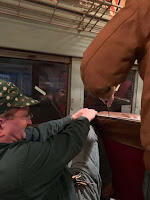Frank writes...
You get one guess about what I was up to on Sunday. ...did you guess "seats in the 460?" Then you win the prize - Andy Sunderland's voice on your home answering machine! But I digress.
I could have called today's post "I get by with a little help from my friends" because it was a real team effort. To start the day, Greg and Good Nick helped me use the Taylor-Dunn to take all the old seats from the 460 that we'd already removed over to the 451 for storage. We also brought back all the reupholstered seat backs and a few cushions. Above, you can see the interior of the 460 with fewer old seats and more new seats stored throughout the car.As we go along, we're steadily refining the process for replacing these seats. The seat backs are attached with three 1/4-20 machine screws that go in through the tubular frame along the top (the seat backs have wooden frames but these screws thread into steel inserts), plus anywhere from zero to three wood screws that go at the bottom from underneath the cushions. They seat into the base of the frame. It's a tight fit, which of course is intentional. The antimacassars add a degree of difficulty, because not only do we need to wedge the new seats into place, but we need to line up the original holes in the antimacassars with the holes in the tubular frame and the threaded steel inserts. Some of the seats only need a "normal" amount of horsepower to get into place; above, I'm using an awl to ensure the seat back is positioned correctly in line with the frame.
And then sometimes you really need to push to get the seat back seated all the way into the frame. Above, I'm pulling on the seat frame for leverage and pushing on the seat back with my knee while Nick (right) gets an awl into the hole. The previous two photos were taken by Zach while we were working on the second of today's seats to be installed.
As we line up the holes, it's helpful to "pin" them in place with an awl or a punch. One of our volunteers works for Metra in car maintenance, and he reports that pinning fabric to seat frames is done much this way by the professionals. In the view above, this is an initial test fit without the antimacassar in place; once the threaded inserts are located, small holes in the fabric are created and a tap is used to chase the threads and get rid of any upholstery material.
Above, the first seat we installed Sunday was a real bear - it was just an extremely tight fit. Richard, shown finishing up the process by running the machine screws in, was instrumental in getting this seat installed. Jimmy is in the background looking on.
Here's Zach testing out one of the newer seats.
At the end of the day, the car looked like this. We got three more seats installed with a fourth started.
We're making good progress! The majority of the non-bulkhead seats have now been replaced.
So, what else was going on? There was a group from another museum visiting, so a few of the guys were showing them around and discussing joint exhibit opportunities. Richard, Will, Ashton, and Matt moved the (extraordinarily heavy) IC Highliner adapter coupler from the cars in Yard 14 over to the cars in Yard 5 so that track 51 can be switched out at some point. Jimmy was working on testing recent air brake work on the 309 and 460.
Above, Nathan was working on cleaning out a gummed-up double check valve from the D13 that was affecting operation of the straight-air side of the brake system. We're hoping to operate the dump car for the public once or twice this coming year. It was very popular when we ran it briefly on Showcase Weekend this past year, and although it failed following a few trips, that issue (a blown control resister) was fixed pretty shortly afterward.
Thanks to Richard and the others who concluded a mutually beneficial trade between IRM and another organization over the past week. Among the items we received were a set of batteries for CTA 2200s, shown here, which our set needs; the control box and "card box" behind, which I believe are for CTA 2400s; and some other 'L' car parts.
Above, Nathan was working on cleaning out a gummed-up double check valve from the D13 that was affecting operation of the straight-air side of the brake system. We're hoping to operate the dump car for the public once or twice this coming year. It was very popular when we ran it briefly on Showcase Weekend this past year, and although it failed following a few trips, that issue (a blown control resister) was fixed pretty shortly afterward.
Thanks to Richard and the others who concluded a mutually beneficial trade between IRM and another organization over the past week. Among the items we received were a set of batteries for CTA 2200s, shown here, which our set needs; the control box and "card box" behind, which I believe are for CTA 2400s; and some other 'L' car parts.










2 comments:
Nice to see the teamwork. Awl bet you guys are having fun even with the hard work. And Joel looks happy about the trade. Hopefully the recipient museum will get more operational/restored equipment going, and everyone succeeds.
o anderson
Post a Comment